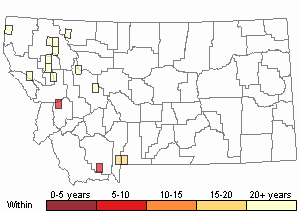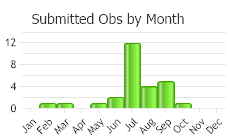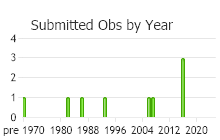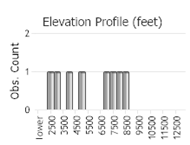View in other NatureServe Network Field Guides
NatureServe
Montana
Utah
Wyoming
Idaho
Wisconsin
British Columbia
South Carolina
Yukon
California
New York
Beaked Plagiomnium Moss - Plagiomnium rostratum
General Description
Plants: Acrocarpous, growing in tufts (Crum and Anderson et al. 1981) or loose mats (Lawton 1971), pale to deep green, occasionally becoming nearly black over time (FNA 2014). Fertile stems upright (Lawton 1971), 10-20 mm tall; infertile stems sometimes reaching 60 mm (FNA 2014), stoloniferous; rhizoids abundant (Lawton 1971).
Leaves: Smaller and more distant below (Crum and Anderson et al. 1981), wavy and somewhat twisted, bent or curved when dry, plane, or old leaves slightly wavy (FNA 2014), and spreading about 45 degrees when damp (Lawton 1971), 2.5-7 mm in length although not often more than 4 mm (FNA 2014), 2-3.5 mm in width (Lawton 1971), widest in the middle to egg-shaped, narrowing to the widely curved, dull, or shallowly-notched leaf tip, the tip rarely deeply notched, with an acumen or seldom an untoothed cusp; base not or only faintly extending down the stem; margins flat, faintly dentate above, sometimes nearly to the bottom, or occasionally smooth, the teeth dull; costa reaching or exceeding the leaf tip, seldom ending shy of it (FNA 2014).
Leaf Cells: Marginal teeth 1- to 2-celled; cells at the leaf edge arranged in 1 layer, thin and long to short (FNA 2014), thick-walled (Lawton 1971), in 3-5 series; medial laminal cells with length about the same as or a little longer than the width, the cells a little smaller near the margins, occurring in somewhat obscure up-and-down or oblique rows, nonporose (FNA 2014), firmly- to thickly-walled, the angles also thickened (Crum and Anderson et al. 1981).
Phenology
Fruit ripens in the last part of spring and through summer (FNA 2014).
Diagnostic Characteristics
The variation of characters within and among populations of Plagiomnium makes identification difficult without fertile plants (FNA 2014).
Range Comments
North American Range
Canada: NT, AB and BC, ON and QC, NL and NS; USA: AK, from WA to CA, also ID and MT, TX to MS, AR to NC and SC, MI, OH to VT and CT; Mexico: Coahuila (FNA 2014). Known in Montana from Flathead, Gallatin, Glacier, Granite, Lake, Lewis and Clark, and Missoula Counties (Elliott and Pipp 2016).
Observations in Montana Natural Heritage Program Database
Number of Observations: 28
(Click on the following maps and charts to see full sized version)
Map Help and Descriptions
Relative Density

Recency



 (Observations spanning multiple months or years are excluded from time charts)
(Observations spanning multiple months or years are excluded from time charts)
Habitat
Soil, humus (FNA 2014), and soil over stone (Lawton 1971), in woods and on calcareous bluffs . Occurring in lowlands and at medium altitudes (FNA 2014).
Reproductive Characteristics
Archegonia and antheridia associating in the same bract cluster. Seta 1-4 per perichaetium, 15-40 mm tall (FNA 2014), pale to deep yellow (Lawton 1971), turning reddish with age (Crum and Anderson et al. 1981). Capsule 2.5-4.5 mm in length, drooping to level, with an obscure neck (FNA 2014), yellow to ochre (Lawton 1971); stomata, sprinkled over much of the capsule (Crum and Anderson et al. 1981), sunken, the guard cells nearly hidden; exostome teeth yellow with green tones, papillose; endostome processes ochre, papillose, widely perforate, with long and very knobby cilia (Lawton 1971). Calyptra pale brown, nonpapillose (Crum and Anderson et al. 1981).
Stewardship Responsibility
References
- Literature Cited AboveLegend:
 View Online Publication
View Online Publication Crum, H.A. and L.E. Anderson. 1981. Mosses of Eastern North America. 2 volumes. Columbia University Press, New York. 1328 pp.
Crum, H.A. and L.E. Anderson. 1981. Mosses of Eastern North America. 2 volumes. Columbia University Press, New York. 1328 pp. Elliott, J.C. and A.K. Pipp. 2018. A Checklist of Montana Mosses (1880-2018). Updated 3 January, 2020. Montana Natural Heritage Program, Helena, Montana. 73 pp.
Elliott, J.C. and A.K. Pipp. 2018. A Checklist of Montana Mosses (1880-2018). Updated 3 January, 2020. Montana Natural Heritage Program, Helena, Montana. 73 pp. Flora of North America Editorial Committee, eds. 2014. Flora of North America North of Mexico. Volume 28. Bryophytes: Mosses, Part 2. Oxford University Press, Inc., NY. xxi + 702 pp.
Flora of North America Editorial Committee, eds. 2014. Flora of North America North of Mexico. Volume 28. Bryophytes: Mosses, Part 2. Oxford University Press, Inc., NY. xxi + 702 pp. Lawton, E. 1971. Moss Flora of the Pacific Northwest. Hattori Botanical Laboratory. Japan: Yamabuki-cho, Shinjuku-ku, Tokyo. 362 pages plus appendices.
Lawton, E. 1971. Moss Flora of the Pacific Northwest. Hattori Botanical Laboratory. Japan: Yamabuki-cho, Shinjuku-ku, Tokyo. 362 pages plus appendices.
- Additional ReferencesLegend:
 View Online Publication
View Online Publication
Do you know of a citation we're missing? Elliot, J. C. 1993. Second checklist of Montana mosses. Unpublished report. U.S. Forest Service, Region 1. Missoula, MT. 45 pp.
Elliot, J. C. 1993. Second checklist of Montana mosses. Unpublished report. U.S. Forest Service, Region 1. Missoula, MT. 45 pp. Lawton, E. 1971. Keys for the Identification of the Mosses on the Pacific Northwest. Reprinted from 'Moss Flora of the Pacific Northwest'. Published as Supplement No. 2 of the Journal of the Hattori Botanical Laboratory. Nichinan, Miyazaki, Japan. 66 pp.
Lawton, E. 1971. Keys for the Identification of the Mosses on the Pacific Northwest. Reprinted from 'Moss Flora of the Pacific Northwest'. Published as Supplement No. 2 of the Journal of the Hattori Botanical Laboratory. Nichinan, Miyazaki, Japan. 66 pp. Malcolm, B., N. Malcolm, J. Shevock, and D. Norris. 2009. California Mosses. Nelson, New Zealand: Micro-Optics Press. 430 pp.
Malcolm, B., N. Malcolm, J. Shevock, and D. Norris. 2009. California Mosses. Nelson, New Zealand: Micro-Optics Press. 430 pp. Smith, A.J.E. 1980. The Moss Flora of Britain and Ireland. Cambridge University Press, Cambridge. 705 pp.
Smith, A.J.E. 1980. The Moss Flora of Britain and Ireland. Cambridge University Press, Cambridge. 705 pp.
- Web Search Engines for Articles on "Beaked Plagiomnium Moss"





